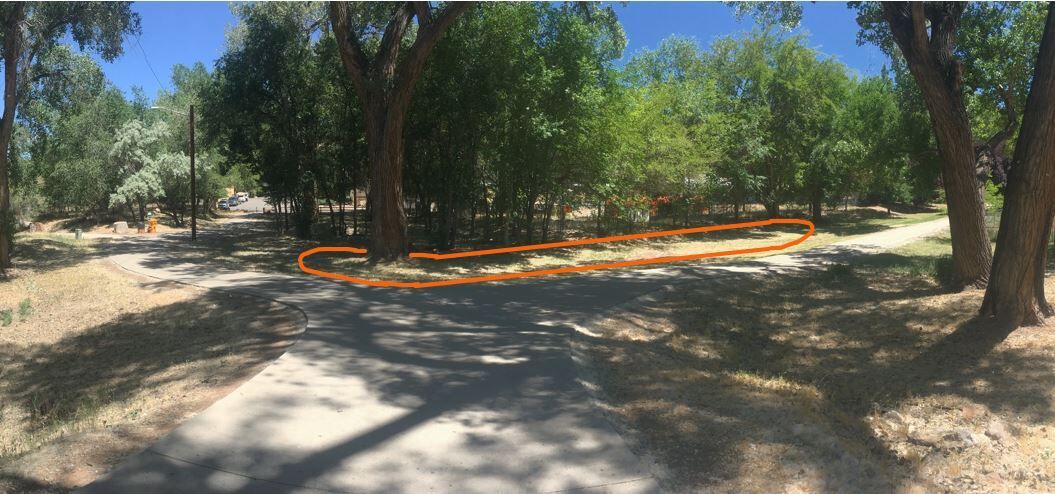Some information may be outdated.
A city park focused on developing basic bike skills is moving ahead despite continued controversy over its location.
Opponents say their objection isn’t to the bike park, but to the location: a shady area along the Mill Creek Parkway. Park planners and concerned citizens have been engaged in a contentious back-and-forth over the potential impacts from and alternatives to the current park design.
The debate over a small park has illuminated larger issues with how the public is involved in decisions about city property; that may impact how elected officials and staff approve plans in the future.
Bike park recap
The planned bike park along the Mill Creek Parkway consists of a fenced-off circuit of ramps and obstacles designed to foster basic technical biking skills like balance and body positioning. The project will also include a restroom with flush toilets and a stormwater drainage system.
[See “Beginner bike skills park planned along Mill Creek path” in the June 7 edition of this paper. -ed]
Critics of the plan cite the need for grading, worries about trees and vegetation, and the loss of peace, quiet, and wildlife habitat in that location. Other proposed locations have been rejected, however.
In response to concerns about crowding and noise, park planners have emphasized that the park is intended for slow-speed skills practice, meant to be child-friendly, and specifically aimed at local residents who can reach the park by bicycle, though tourists may use the features as well.
A surprise to some
The project was not subject to a public hearing because the amounts of money the city committed to it are below $50,000, the threshold that would trigger such a process.
Through an interlocal agreement, the city promised the county Division of Active Transportation and Trails, which is spearheading the project, $30,000 a year for two years. $30,000 will go to the park and $30,000 will be used for the bathroom.
The remainder of the project cost, approximately $63,000, is covered by a grant from the Utah Office of Outdoor Recreation secured by the Division of Active Transportation and Trails.
While the project had been discussed at city council meetings, many critics of the project have said they felt blindsided when they learned of the park just a few months before construction was set to begin.
Larger network or local park?
The original grant request framed the bike skills park as “phase one” of a network of urban bike infrastructure projects along the Parkway, including features near Grand County High School and Rotary Park.
Maddie Logowitz, manager of the Division of Active Transportation and Trails, clarified that this idea is subject to the will of the Moab City Council and funding for the current bike skills project is not tied to any potential future bike infrastructure.
“The concept described in the grant is only a concept, not a concrete plan,” Logowitz said. “Describing this project as a phase gives the City the option to apply for more grant funding for related projects in the future, should they wish, but there is no obligation to do so.”
However, Moab City Councilmember Mike Duncan was surprised to see the grant request. Duncan commented that it appeared as though park planners were sketching two different narratives for different audiences: a large bike network that would draw tourists and boost the local economy while also serving residents to appeal to businesses and the Utah Office of Outdoor Recreation, while presentations to the council and residents described the park as a quiet, stand-alone feature meant to serve young children of local families.
Logowitz said in an email to the Moab Sun News that this discrepancy is due to changes made in response to community input since the grant application was submitted in 2019.
For example, she said, the current target age group of the park is younger than the demographic identified in the grant; the grant application also says the park will be advertised to tourists, but Logowitz now thinks that would be inappropriate in light of public feedback.
Duncan thinks that the discrepancies between the grant application version of the park and the version most recently presented to the council could potentially be grounds for the city to consider revoking their permission to use the Parkway location.
“I’m not advocating that the City take that action without a public hearing first,” Duncan said. He doubts, however, that a public hearing would sway the will of the council. The majority has, so far, declined to consider breaking their agreement with the county.
Changing the process
If the city does decide to pursue another bike infrastructure project in the future, the process will certainly look different.
Backlash over the current project has been so fierce that the city council has asked staff to design a process to publicize changes in use on city property and assess citizen support and incorporate public input before undertaking projects.
At a recent Moab City Council session, an unrelated proposal to create a new community garden plot on city property behind Bartlett Circle near Anonymous Park met with resistance from council members due to the lack of a formal process, budget woes and the controversy of the bike skills park. The council was unwilling to make any commitments to local nonprofit Moab Community Gardens, who pitched the idea, and postponed consideration of the proposal until city staff have come up with a new change-in-use public engagement procedure.
In the meantime, grading and preparations for the construction of the bike skills park is scheduled to begin in mid-August.
For more information about the bike skills park, visit www.grandcountyutah.net/1090/Mill-Creek-Path-Bicycle-Skills-area-FAQ
Bike park shows problems in city approval process
Appreciate the coverage? Help keep local news alive.
Chip in to support the Moab Sun News.





